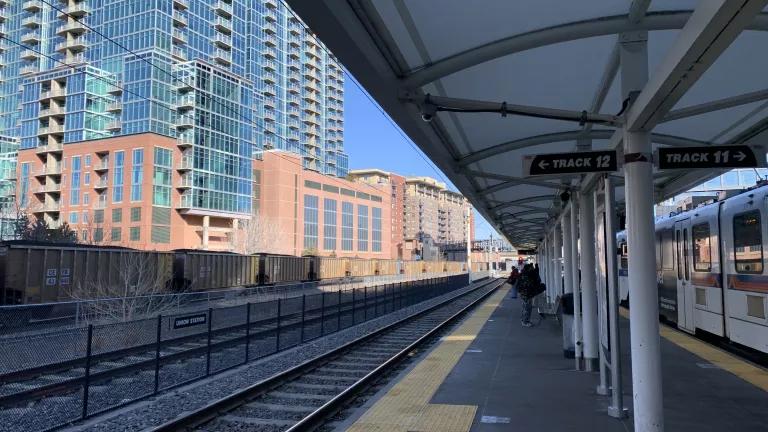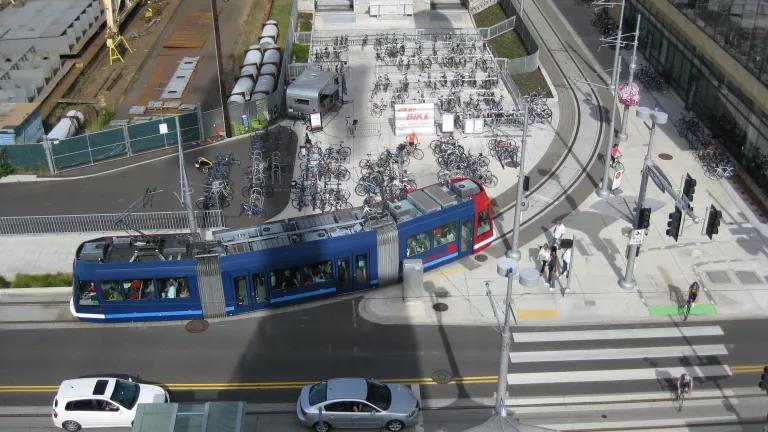Transportation in the Bipartisan Infrastructure Law: Are We There Yet?
The historic infrastructure law just passed the one-year mark from its enactment. What kind of transportation investments have been made, and what's next for the law?

Transportation criss-crosses the country
The historic Bipartisan Infrastructure Law was enacted a year ago this week, as my colleagues Shelley Poticha and Valerie Baron wrote about yesterday.
What many don’t realize is that the Biden administration and Congress delivered this law by taking advantage of a big job already facing Congress last year: the expiration of the nation’s surface transportation law, which was extended twice to the end of 2021. A lot of additional investments were piled into this must-pass bill, with transportation program reauthorization as the legislative vehicle carrying it all.
The good news is that federal, state, and local transportation agencies have enormous leeway in the implementation of the transportation provisions of the law since they are highly flexible in terms of eligible uses of funding.
So, what have they been investing in thus far?
“Highway” and competitive grant programs
First, in tallying up the figures from a new fact sheet about the law, the U.S. Department of Transportation (DOT) and its grantees at the state and local levels have moved very quickly to commit enormous sums of money for transportation projects nationwide. The White House unveiled a map summing up all investments within states pursuant to the law, and scrolling across it shows just how much of the money comes from the DOT (three-quarters or more for most states). The vast majority ($120 billion spread over fiscal years 2022 and 2023) goes to road and bridge accounts, courtesy of the largest modal administration within the DOT—the Federal Highway Administration (FHWA).
Where is this money going? To get an idea, we can look at state spending habits in the period right before this law took effect. The American Road & Transportation Builders Association has helpfully tallied up and mapped out FY21 highway spending nationally and by state, providing more detail on spending categories for this money. Overall, the good news is that 43 percent of the funding went to repair and reconstruction of existing facilities, with only 27 percent going to build new capacity. However, that masks substantial variation across states, ranging from a low of 14 percent for repairs in Arizona, Delaware, Georgia, and Virginia to 70 percent or more in Minnesota, Nebraska, and South Dakota. It will be interesting to see how states invest the massive influx of new highway dollars from this law.
What about vehicle electrification? The good news is that U.S. and state transportation departments moved especially quickly on this front, with all 50 states submitting National Electric Vehicle Infrastructure program plans and DOT approving them. These plans are substantial, routinely spanning more than 50 pages. However, other than rubber-stamping them, DOT has not published any analysis or assessment of them. This is a missed opportunity—thus far, since it would be valuable anytime!—because best practices in these plans should be highlighted so they can be replicated in the future. And states as well as advocates eagerly await other important next steps from DOT; namely, the finalization of standards and guidance for implementation of the plans.
One area that many advocates are focused on is the use of federal highway formula dollars. To FHWA’s credit, just a month into the law’s implementation, acting administrator Stephanie Pollack issued guidance to staff, a six-page memo including these paragraphs:
Under this policy, FHWA will work with recipients of any federal funds made available under Title 23, United States Code to encourage and prioritize the repair, rehabilitation, reconstruction, replacement, and maintenance of existing transportation infrastructure, especially the incorporation of safety, accessibility, multimodal, and resilience features. Projects to be prioritized include those that maximize the existing right-of-way for accommodation of non-motorized modes and transit options that increase safety, accessibility, and/or connectivity.
FHWA staff shall encourage metropolitan planning organizations, state transportation departments, FLMAs [Federal Land Management Agencies], and other decision makers and recipients of federal-aid highway and federal Lands funding to consider the following factors before advancing projects that result in new capacity for single-occupancy vehicles:
- progress in achieving a state of good repair consistent with the state’s asset management plan under 23 U.S.C. 119(e);
- how the project will support the achievement of the state’s performance targets under 23 U.S.C. 150 (including any new performance targets established by FHWA); and
- whether the project is more cost-effective than both operational improvements to the facility or corridor and transit projects eligible under chapter 53 of Title 49.
This is especially important guidance for investments from the two largest “highway” programs, which are available for many uses other than roadbuilding: the National Highway Performance (NHPP) and Surface Transportation Block Grant (STBG) programs. Congress has made these programs more and more flexible over the years, and, in fact, the latter was originally created in 1991 to encourage states to use this funding for other purposes, such as public transportation in the wake of Interstate Highway System completion. And with this new law, funding from these programs can also be used for electric vehicle charging stations, which would be a game changer for auto electrification, energy security, and climate change, as my colleague Max Baumhefner and I covered in an earlier blog.
The overreaction to this FHWA guidance memo in the first half of 2022 was bananas. Minority Leader Mitch McConnell urged governors to disregard it. Members of Congress peppered Secretary of Transportation Pete Buttigieg with criticism. So much noise about commonsense guidance encouraging responsible use of our taxpayer dollars! In fact, exercising the flexibility Congress built into these programs has never been more important because they never received this much money: At about $200 billion combined, NHPP and STBG eclipse all other programs in size.
There’s a lot of other funding in this law. For example, there is about $100 billion in competitive grant-making authority for the DOT, another historic first. And here is where Secretary Buttigieg and his team have truly excelled. They have issued Notices of Funding Opportunity (NOFOs) at an accelerating clip, and have already made some interesting investments. For example, they’ve approved a first round of impressive RAISE program grants, and, as Yonah Freemark of the Urban Institute noted, the investments are more environmentally friendly than those made from this program during the Trump administration. And the INFRA (Nationally Significant Multimodal Freight and Highway Projects) program, designed to improve freight transportation, included among its 26 awards (totaling $1.5 billion) a noteworthy grant to Detroit to transform a highway that had rammed through Black neighborhoods into a boulevard that will connect, not divide, those parts of the city. This last investment is one you’d expect from the smaller Reconnecting Communities Pilot Program, which was created to tear down and/or redesign such racially unjust, harmful bridge and road projects. There are NOFOs out for Reconnecting Communities and an increasing number of other programs, signaling that we can look forward to innovative grant-making from U.S. DOT in the coming years.
Transit and rail
Transit programs also received a historic increase in funding from the infrastructure law, though they still only represent about 20 percent of what highways get. Like DOT and FHWA, the Federal Transit Administration (FTA) has been busy issuing NOFOs and awarding funds. We’ve seen NOFOs for small but important new programs, such as the All Stations Accessibility Program to help bring legacy rail stations into compliance with the Americans with Disabilities Act and the Rail Vehicle Replacement Program to establish, for the first time, dedicated federal funding for railcars. FTA also awarded grants under the Low or No Emission Vehicle Program, which existed before the infrastructure law but was plussed up significantly in the bill to expedite the reduction of emissions from transit fleets. The agency is also administering the nearly $13 billion in transit formula grants provided by the infrastructure law in its first year to help transit agencies across the country address their ongoing capital needs. (Day-to-day operating expenses are not eligible for infrastructure law funding except at the smallest agencies.)
Importantly, FTA’s activities have extended beyond grant-making, with staff time and resources dedicated to helping its grantees and other stakeholders make the most of the funding. To cite just a few examples, FTA released an updated tool to estimate greenhouse gas emissions of transit projects and hosted a joint webinar with FHWA highlighting the flexibility of FHWA’s programs to fund transit-related projects.
In another exciting step, FTA supported the launch of the Transit Workforce Center, the first national center for transit workforce development, which will help local agencies address the ongoing recruitment crisis that is threatening their ability to provide reliable service.
With so much focus on getting infrastructure law funding out the door quickly, it may not be surprising that some of the more technical items on FTA’s to-do list are not yet complete. In July 2021 and again in March 2022 (to consider changes made by the infrastructure law), FTA requested comments on its Capital Investment Program (CIG) guidance, which governs the development of new or expanded rail and bus rapid transit lines. NRDC provided recommendations to improve the way FTA evaluates the environmental and equity impacts of these projects. With $4.6 billion in infrastructure law funding expected to flow through the CIG program in the next five years, updated guidance should be issued as soon as possible.
The Federal Railroad Administration (FRA), historically focused on safety regulation, has continued its transformation into a grant-making agency. The law authorized $102 billion for rail programs ($66 billion in advance appropriations; $36 billion subject to appropriations)—a whopping but warranted 500 percent increase over recent funding levels for rail.
A major focus of the infrastructure law was improving the condition and safety of rail infrastructure to provide better performance. FRA is accepting applications for the Consolidated Rail Infrastructure and Safety Improvements (CRISI) program until December 1, 2022, for projects that will improve the safety, efficiency, or reliability of passenger and freight railroads. Applications are currently under review for the infrastructure law’s new Railroad Crossing Elimination Grant Program to reduce the potential for conflicts between trains and motor vehicles.
As we finish this first year, we can look back at an impressive and accelerating investment strategy by U.S. DOT, pursuant to the Bipartisan Infrastructure Law, especially with its historic competitive grant-making authorities. The real impacts and outcomes of the law remain to be seen, since most of the funding is doled out by formula to states and metropolitan organizations.
With this first lap completed, we still have four more years in this race to upgrade our surface transportation infrastructure (until these provisions will need to be extended or renewed). Here’s to continued leadership by U.S. DOT and increasing innovation and improvements in local and state investment strategies, where the rubber really hits the road.



